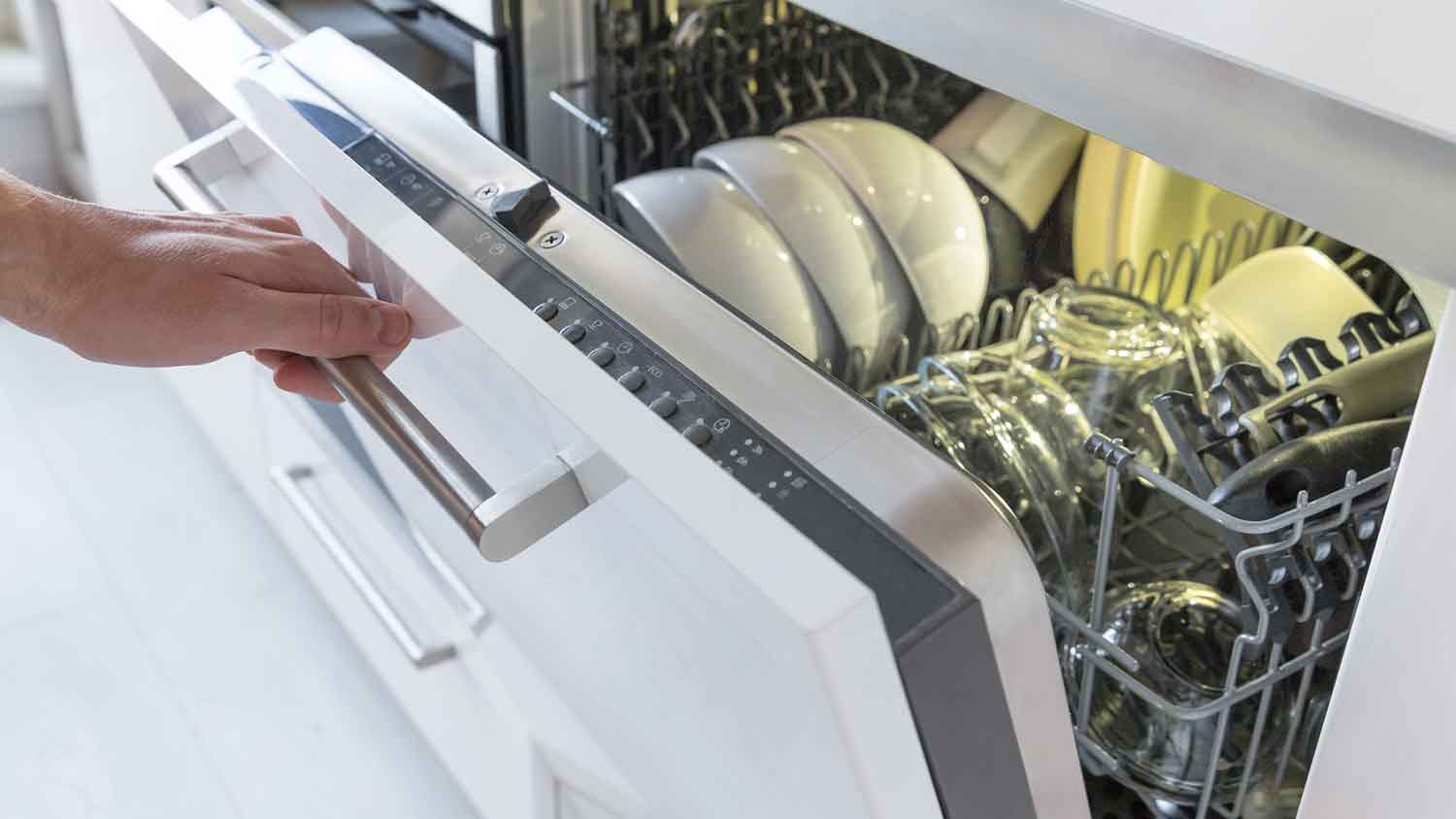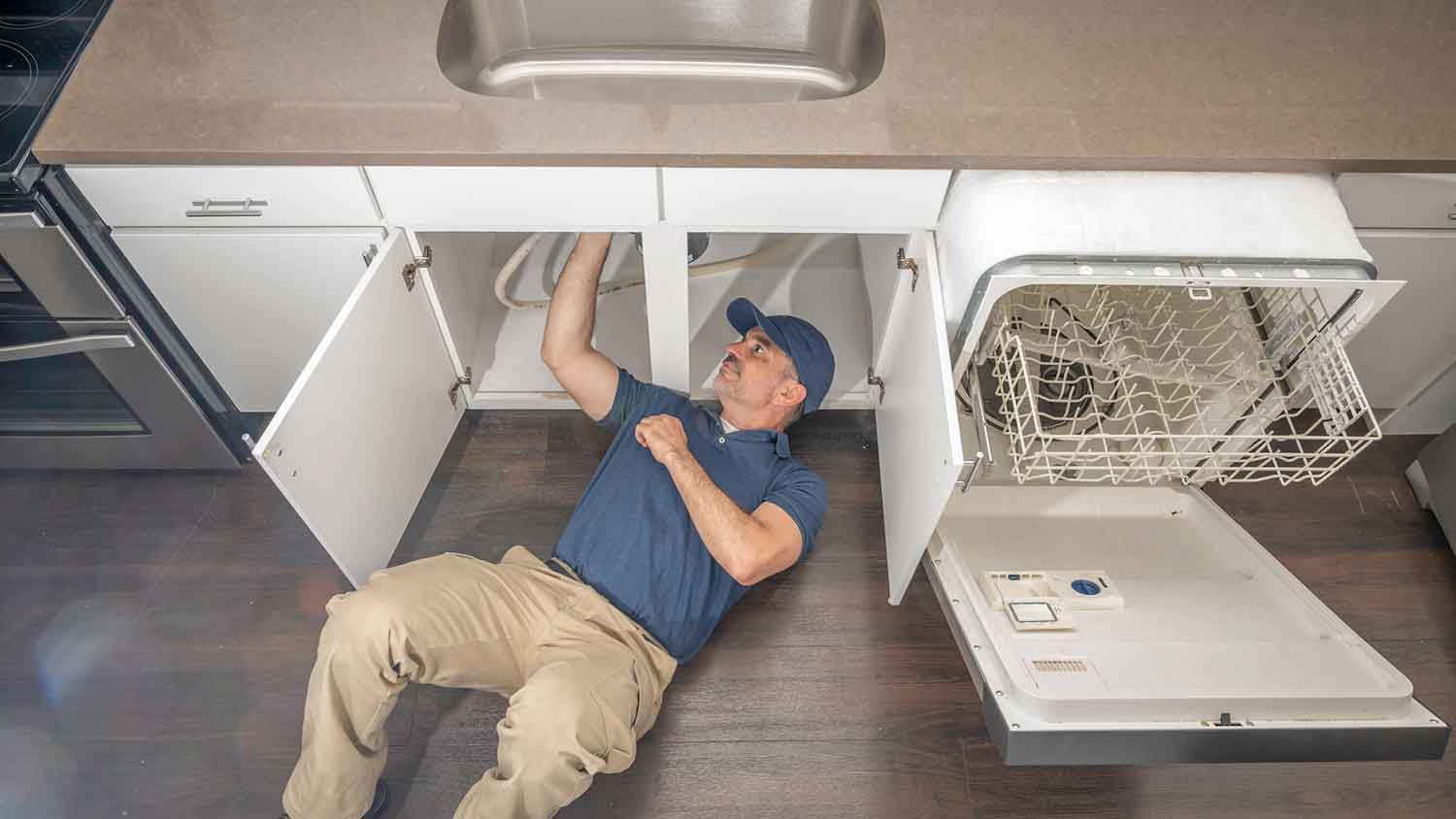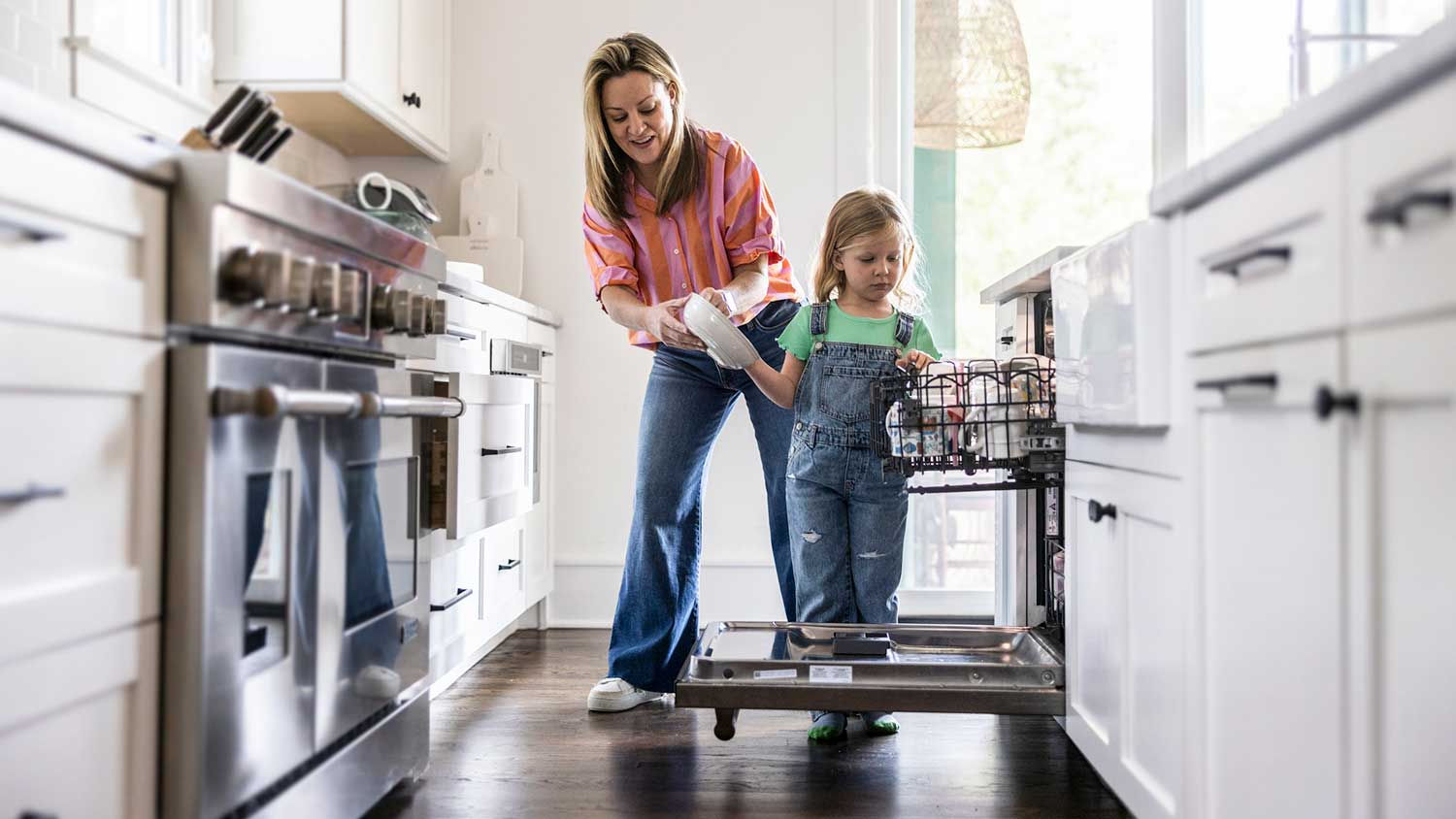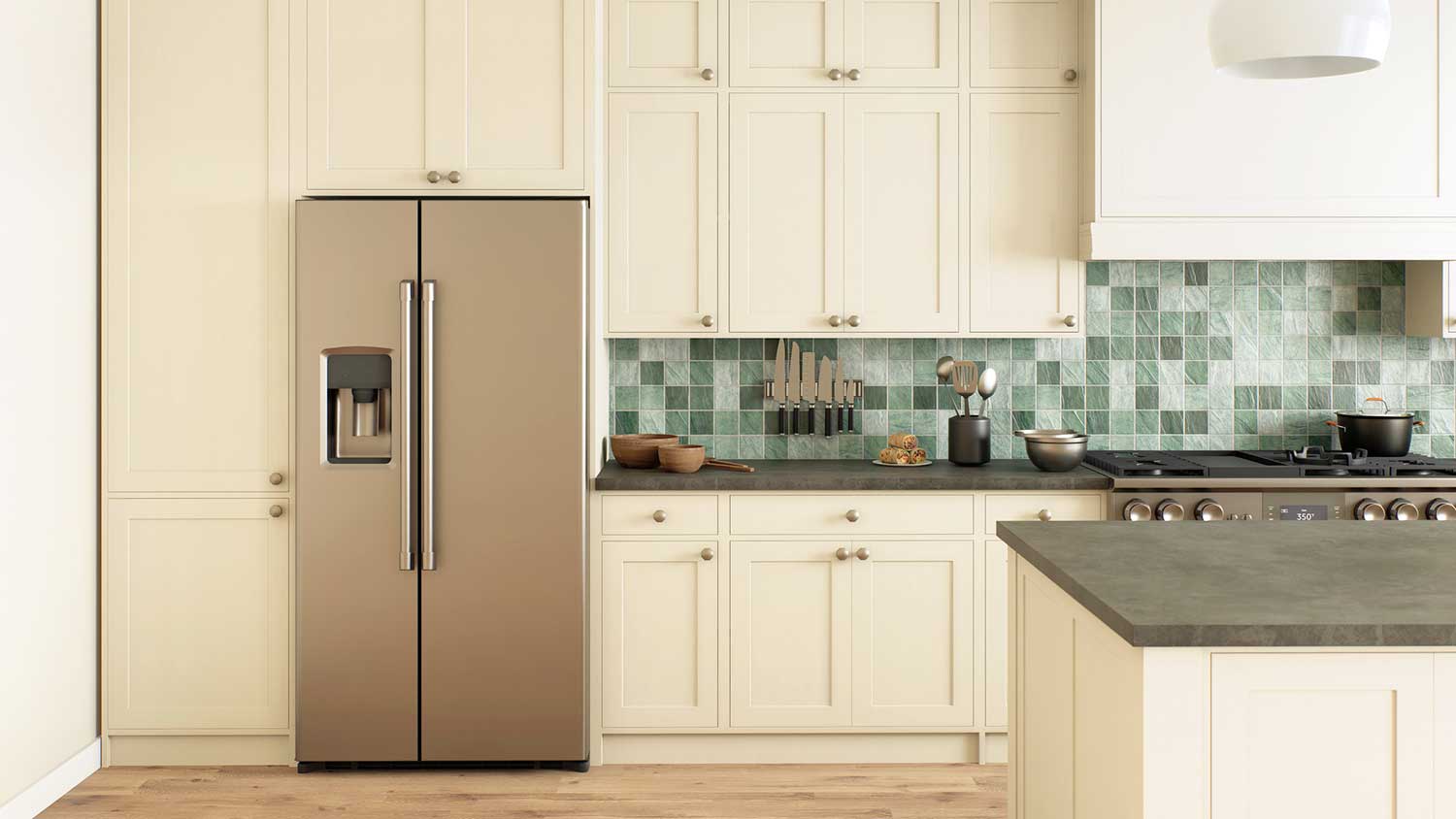9 Reasons Your Dishwasher Is Leaking from the Bottom and What to Do
Your dishwasher should be cleaning dishes—not the floor


A dishwasher leaking from the bottom can have several causes.
Some dishwasher problems—such as a damaged gasket or clogged filter—are easy to fix yourself.
You might need to call a professional for internal repairs, which costs $200 on average.
If the dishwasher is severely broken, or if you have an older model that’s nearing the end of its life, you may consider replacing it instead.
To prevent water damage, regularly check your dishwasher for signs of dampness, mold, and pooling water.
If puddles of water mysteriously appear after running the dishwasher, you’ll want to figure out how to stop the problem before water damage strikes. While homeowners insurance can cover water damage, taking action is important for a clean, safe, and mold-free home. Here are some common reasons why your dishwasher is leaking from the bottom and how you can solve the issue.
To reduce the risk of water damage caused by faulty appliances, make it a habit to check for signs of dampness, mold, and pooling water monthly.
1. You Have a Damaged Gasket
The gasket is a rubber seal that surrounds the door of your dishwasher to prevent leaks. Rubber gaskets are prone to typical wear and tear, so check them first while troubleshooting your leaky dishwasher. Inspect the gasket for signs of stretching, tears, deterioration, and mineral deposits to see if it's time to replace the gasket.
How to Fix It
As one of the most common causes for a dishwasher leaking from the bottom, you're in luck when it comes to fixing this problem. Gaskets are easy and affordable to replace. Simply do the following:
Buy the correct-sized door seal for your appliance.
Remove the old, faulty gasket.
Clean the door using mild soap and warm water.
Warm up the new door seal with a blow dryer set to low heat to remove creases.
Press the seal onto the sides of your door without stretching it.
2. The Dishwasher Latch Isn’t Latching

A broken, bent, or loose door latch can cause mayhem for your dishwasher’s seal. Without the latch, the door won't shut fully, increasing the likelihood of water leaking out of the dishwasher. In this case, water may look like it's leaking from the bottom of your dishwasher, when in reality, it's running down the sides.
How to Fix It
If you have a loose latch, try using a screwdriver to tighten it. Bent latches may be able to be straightened out, but if that doesn't work, or your latch is broken entirely, then you'll need to replace the latch. Check the make and model of your dishwasher to find a compatible replacement latch. Most latches are easy to replace yourself, so hiring a professional to do the job will cost you more than it's worth.
3. Your Dishwasher Filter is Clogged
Filters are great for catching food particles, but when your filter is clogged, it can cause a leaky dishwasher. Instead of the water draining as it should during a typical cycle, it can become backed up and trickle out of your dishwasher’s basin.
How to Fix It
You shouldn't have to do much to fix this issue. Simply clean the filter with soap and water to remove debris, mineral deposits, grease, and food particles. This is also a good time to clean the bottom of your dishwasher, as a clogged filter won't catch all of the food particles, leaving them to accumulate in your dishwasher.
4. You have a Faulty Dishwasher Hose

Having a loose or damaged dishwasher hose can cause large, noticeable leaks and pools of water under your dishwasher. Dishwasher hoses connect your dishwasher to the water supply. These connections can easily come loose or corrode over time and are a common reason for a dishwasher leaking from the bottom.
How to Fix It
Look at the external and internal connections attached to your dishwasher to see if there are any signs of tears or corrosion. You can also gently move the hoses to see if they are loose. A loose dishwasher hose can be tightened, but a faulty dishwasher hose needs to be replaced with a compatible replacement part.
5. The Inlet Valve Needs Replacing
The inlet valves go hand-in-hand with dishwasher hoses. If you suspect an issue with the connections of your dishwasher, and it's not your hose, then the next area you should inspect is the inlet valves. Inlet valves allow the water to enter your dishwasher from the hot and cold water hoses.
If the dishwasher inlet valve breaks or becomes loose, then you'll notice a decrease in the speed at which your dishwasher fills and how well your dishwasher cleans your dishes on top of any leak.
How to Fix It
Fixing the inlet valve may only be a matter of tightening the valve, but a broken inlet valve requires a replacement part. Replacing the valve is a straightforward and affordable fix. Just be sure to choose a compatible part according to your dishwasher’s make and model.
6. The Dishwasher Tub Is Broken
If you have a broken dishwasher tub, then the basin that holds the water and dish baskets is corroded or cracked. Like a cup with a crack at the bottom, any water in your dishwasher will quickly flow out the bottom of the appliance.
How to Fix It
Some dishwasher tubs can be repaired with caulk and a little TLC. For larger cracks or extensive damage, you may need to replace the tub entirely. This may not be a cost-effective choice if your dishwasher is an older unit. Dishwasher tubs are more complex to replace than simply replacing an inlet valve, hose, or latch. So if your dishwasher is over 10 years old, you’re probably better off getting a new unit.
You might need a dishwasher repair technician to replace the tub, which can make the dishwasher repair cost more expensive than replacing the dishwasher.
7. You’re Using the Wrong Detergent

If you're using dish soap as a dishwasher detergent, this could be why your dishwasher is leaking from the bottom. Also, gently cleaning your dishes before placing them in the dishwasher can add excess lather if you don’t fully rinse soap residue off the dishes. All those suds can add too much pressure to the seal of your dishwasher door, leading to that infamous leak.
How to Fix It
Try changing up your dishwasher detergent if you suspect that it’s too soapy. Don't pre-wash your dishes with dish soap prior to putting them in the dishwasher. And don't use more dishwasher detergent than recommended.
8. Your Dishwasher Isn’t Level
A wobbly dishwasher can really shake things up—especially when it comes to water. If your dishwasher isn’t level, water has a higher risk of overflowing in the tub and leaking out beneath the machine.
How to Fix It
To fix an unlevel dishwasher, put a level on the top of your dishwasher to first confirm that it’s not level. If you see that it’s not level, keep a mental note of which side is higher than the other. Then, you’ll need to unplug the appliance, unscrew the cabinet anchors, disassemble the panel and insulation, and adjust the legs of the appliance until the level is centered.
Since this fix requires several steps, you may prefer to work with an appliance technician to correctly uninstall, level, and reinstall the appliance.
9. Dishwasher Pump or Other Internal Parts Need Repairing
Sometimes, internal parts inside your dishwasher need repairing. If you can't find the source of the leaky dishwasher, and you've tried every other solution, then you may need a technician to service your unit. Examples of internal parts include the water pump and float switch.
How to Fix It
Fixing any internal issues will depend on the diagnosis from a technician. Many issues can lead to your dishwasher leaking from the bottom—with some problems being much easier to resolve than others. For example, a broken water pump requires more elbow grease than, say, replacing an interior hose.
No matter the cause, you should make it a monthly habit to check your appliances for signs of dampness, mold, and pooling water. This includes checking your water heater, dishwasher, washing machine, and refrigerator for leaks. Knowing how to check for mold in your home can save you on high water damage remediation costs down the line.
Repairing vs. Replacing your Dishwasher
Dishwasher repair costs $200 on average. Usually, if you only need to replace one or two faulty parts, fixing the dishwasher would be the better option. However, more complicated problems like a faulty control panel or a broken tub would cost more to get fixed. Therefore, if the dishwasher is beyond repair, or if you have an older model that has been causing you trouble, you may consider replacing it.
A standard 24” built-in dishwasher costs between $400 and $1,200. Countertop options with smaller capacities are more affordable, ranging between $200 and $500. If you have a home warranty policy, the cost to replace your dishwasher is often covered.
When to Call a Pro
A leaking dishwasher isn’t always the hardest problem to address. For example, if you need to get a new filter, switch to a different detergent, or add some padding to level the appliance out, you can definitely handle the job yourself. Even replacing the inlet valve or the gasket can be done by yourself.
That said, you should always hire a professional dishwasher repair service if the damage is more severe or affecting the internal parts. A repairperson would also tell you if replacing your dishwasher is better.
What's more, if the dishwater has spilled, you will need to hire a water damage restorer to ensure the affected area and objects are thoroughly dried and disinfected. Water restoration for gray water costs about $5.25 per square foot.
How to Prevent a Dishwasher Leaking from the Bottom
Follow these tips to prevent a leaky dishwasher:
Don’t overload the dishwasher.
Regularly clean the dishwasher filter for proper drainage.
Wipe down the gasket to prevent build-up of debris, and replace when it’s showing signs of wear.
Use the right amount of detergent (and the right kind).
Rinse dish soap off of dishes before loading them into the dishwasher.
Regularly inspect components such as the drain hose, spray arms, and inlet valve.
Replace your dishwasher after 10 to 12 years, or whenever it starts having issues.
The average lifespan of a dishwasher is typically 10 to 12 years. However, this is heavily based on factors like frequency of use, brand quality, and how well it's maintained. Regular cleaning, proper loading, and addressing minor issues quickly can help extend its life beyond this average. On the other hand, heavy use or neglecting maintenance can lead to a shorter lifespan, requiring more repairs or a faster need for replacement.
It's often worth fixing a leaking dishwasher, especially if it's a minor issue like a damaged gasket or clogged filter, which are inexpensive DIY repairs. However, if your dishwasher is over 10 years old or the repair cost approaches half the price of a new unit, replacement might be more cost-effective.
Yes, even a small dishwasher leak is a big deal. While it might seem minor, continuous unnoticed drips can lead to significant water damage to your kitchen floor, subfloor, and cabinetry. This damp environment is also a perfect breeding ground for mold, which can cause health issues and expensive mold remediation. Remember that water and electricity don't mix—having even a small leak poses a potential electrical hazard. Addressing any leak as soon as possible protects your home and avoids costly future repairs.





- Appliance Repair Companies
- Washing Machine Repair
- Dryer Repair
- Refrigerator Repair
- Dishwasher Repair
- Oven Repair
- Wood & Pellet Stove Repair
- Freezer Repair Services
- Wood Stove Services
- Gas Stove Repair
- Emergency Appliance Repair Companies
- Ice Maker Repair
- Gas Appliance Repair
- GE Appliance Repair
- GE Refrigerator Repair
- GE Dryer Repair
- GE Dishwasher Repair
- GE Washing Machine Repair
- Samsung Appliance Repair
- Samsung Refrigerator Repair
- Samsung Dryer Repair
- Samsung Washer Repair
- Samsung Dishwasher Repair
- Samsung Oven Repair
- Whirlpool Repair
- Whirlpool Refrigerator Repair
- Whirlpool Washer Repair
- Whirlpool Dryer Repair
- Whirlpool Oven Repair
- Maytag Appliance Repair
- Maytag Refrigerator Repair
- Maytag Washer Repair
- Maytag Dryer Repair
- Maytag Dishwasher Repair
- Kitchenaid Appliance Repair
- Kitchenaid Oven Repair
- Kitchenaid Refrigerator Repair
- Kenmore Appliance Repair
- Kenmore Dishwasher Repair
- Kenmore Washer Repair
- Kenmore Dryer Repair
- LG Refrigerator Repair
- Bosch Appliance Repair
- Kenmore Refrigerator Repair
- LG Appliance Repair Services
- GE Microwave Repair
- Electrolux Appliance Repair
- Electrolux Washer Repair
- Kitchenaid Dishwasher Repair Services
- Wood Stove Inspection
- Dishwasher Installation
- Trash Compactor Repair











